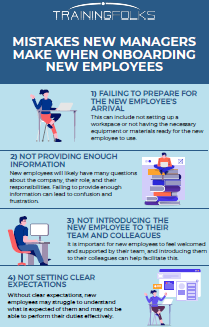Reducing Turnover: Developing a Training Program for New Employees

Reducing turnover is key to many successful companies. Developing a training program for new employees is important, however, employee onboarding is a critical process that can have a significant impact on a company's turnover rate and employee retention. When done properly, onboarding can help new employees feel welcome, informed, and prepared to succeed in their new roles. In contrast, a poor employee onboarding experience can leave new hires feeling confused, unsupported, and disengaged, which can ultimately lead to turnover.
Research has shown that effective onboarding programs can help reduce turnover rates by up to 50%. This is because onboarding helps new employees feel more connected to their company and colleagues, understand their roles and responsibilities, and have a clear idea of what is expected of them, which sets the foundation for their success when they first join the company.
By providing new hires with the tools and resources they need to succeed, companies can increase employee satisfaction and engagement, which can in turn lead to higher retention rates.
The Importance of Employee Onboarding
Employee onboarding is the process of integrating new employees into an organization and familiarizing them with the company's culture, policies, and procedures. It is a critical step in the hiring process and can greatly impact employee retention and turnover rates.
In this section, we will discuss what employee onboarding is, why it is important, and the impact of poor onboarding.
What is Employee Onboarding?
Employee onboarding is the process of welcoming and integrating new employees into an organization. It involves providing them with the necessary tools, resources, and information to be successful in their roles. This includes developing a training program for new employees.
This includes introducing them to the company's culture, policies, and procedures, as well as providing training and support to help them acclimate to their new environment.
Why is Employee Onboarding Important?
Employee onboarding is important for several reasons. First, it sets the tone for the employee's experience with the company. A positive onboarding experience can help new hires feel welcomed, valued, and engaged, which can lead to higher job satisfaction and lower turnover rates.
Second, it helps new employees understand their roles and responsibilities, which can lead to higher productivity and performance. Third, it helps new employees build relationships with their colleagues, which can lead to a more collaborative and supportive work environment.
The Impact of Poor Onboarding
Poor employee onboarding can have a significant impact on employee retention and turnover rates. When new employees do not receive the necessary support, training, and resources to be successful in their roles, they may become disengaged, frustrated, and ultimately leave the company.
This can be costly for organizations, as it can result in lost productivity, increased recruiting and training costs, and decreased morale among remaining employees.
Best Practices for Employee Onboarding
Developing an effective onboarding program is crucial for reducing turnover rates and boosting retention.
Here are some best practices to help ensure a successful onboarding experience:
Developing an Onboarding Program
The first step in creating a successful employee onboarding program is to establish a clear plan for new hires. This includes outlining the goals and objectives of the program, as well as the specific tasks and activities that will be included in the onboarding process.
It's also important to assign a mentor or buddy to each new hire to help guide them through the process and answer any questions they may have.
Another key component of developing an effective onboarding program is to provide new hires with the necessary training and resources they need to succeed in their new role. This may include job-specific training, as well as training on company policies, procedures, and culture.
Creating a Positive Onboarding Experience
Creating a positive onboarding experience is essential for engaging new hires and making them feel welcome and valued. This can be achieved by providing a warm and welcoming environment, as well as by introducing new hires to key members of the team and providing opportunities for them to socialize and connect with their colleagues.
It's also important to ensure that new hires have access to the resources and support they need to succeed in their new role. This may include providing them with the necessary tools and technology, as well as assigning a mentor or buddy to help guide them through the onboarding process.
Measuring the Success of Onboarding
Measuring the success of your onboarding program is important for identifying areas for improvement and ensuring that your program is meeting the needs of your new hires. This can be done by gathering feedback from new hires, as well as by tracking key metrics such as retention rates, productivity, and employee engagement.
By implementing these best practices, organizations can create a successful onboarding program that helps to reduce turnover rates and boost retention, while also promoting employee engagement, company culture, and training and development.
How Onboarding Boosts Employee Retention
Employee onboarding is an essential process that helps new employees acclimate to their new roles and the company's culture. An effective onboarding process can help new hires feel welcomed, supported, and valued, which can have a significant impact on staff retention. When employees feel supported and valued from the start, they are more likely to develop a positive attitude toward their work, which can lead to increased job satisfaction and a greater commitment to the organization.
Additionally, an effective employee onboarding process can provide new hires with the tools, knowledge, and resources they need to be successful in their roles, which can help reduce turnover by decreasing the likelihood of early job dissatisfaction or performance issues. Overall, a well-designed and executed onboarding program can help organizations retain their staff and build a strong and loyal workforce.
Conclusion
Employee onboarding is critical to reducing turnover. It can have a significant impact on employee retention and turnover rates. A positive onboarding experience can help new employees feel welcomed, valued, and engaged, which can lead to higher job satisfaction and lower turnover rates. Conversely, a poor onboarding experience can leave new hires feeling disengaged and ultimately lead to turnover.
By following best practices for developing an effective onboarding program, organizations can create a positive and engaging experience for new employees, which can help reduce turnover rates and boost retention. By investing in their employees from the start, organizations can build a strong and loyal workforce that is committed to the success of the company.
Ready to learn more? get our FREE Infographic Download:
'Mistakes New Managers Make when Onboarding New Employees'


